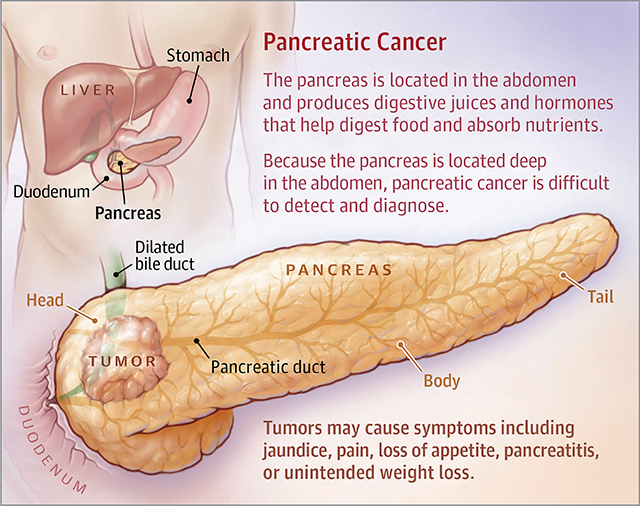Abstract
Pancreatic adenocarcinoma is a serious disease caused by abnormal cells in the pancreas that divide and grow out of control, forming a tumor.
Graphical Abstract

The pancreas is located deep in the abdomen, behind the stomach and in front of the spine. It has 2 main functions, to produce digestive juices for the small intestine to digest and absorb food and to produce hormones such as insulin to assist cells to absorb nutrients and regulate blood glucose levels. Pancreatic cancer occurs when pancreas cells develop abnormal DNA mutations that make them grow and divide out of control, forming a tumor. Sometimes this tumor spreads to other organs such as the liver, abdominal wall, lymph nodes, lungs, or bones. Pancreatic cancer is the fourth leading cause of cancer death in the United States.
Conditions that increase risk of pancreatic cancer include smoking, chronic pancreatitis, obesity, long-standing diabetes, a strong family history of pancreatic cancer, and diets high in red and processed meats. Research is ongoing into ways to prevent pancreatic cancer. People who have any of these risk factors, especially a family history of pancreatic cancer, should consider participating in research studies or high-risk screening programs and should focus on lifestyle habits such as not smoking and staying active.
Testing for Pancreatic Cancer
Because of the location of the pancreas, pancreatic cancer is difficult to detect and diagnose. Signs and symptoms that may prompt testing include jaundice (yellowing of the skin and the whites of the eyes), abdominal pain, back pain, loss of appetite, pancreatitis, or unintended weight loss. Patients with a family history of pancreatic cancer, especially in multiple family members, should talk to their doctor about whether they might be a candidate for research studies or high-risk screening programs.
Given the location of the pancreas, pancreatic tumors can been seen only with imaging studies such as computed tomography, magnetic resonance imaging, or endoscopic ultrasound. These imaging techniques allow doctors to see tumors as well as see all of the pancreatic and bile ducts to detect blockages. Tissue biopsies may also be performed to help make the diagnosis.
Treatments
Pancreatic cancer is difficult to treat because many cases are diagnosed at a later stage, after the tumor has spread. For cancers diagnosed at an earlier stage, surgery is the best option for cure. For some patients who have surgery and those with later-stage diagnoses when surgery is not possible, chemotherapy (treatment with drugs that kill cancer cells) and/or radiation therapy (using high-energyx-rays to kill cancer cells) are treatment options. There are also many treatments to help relieve symptoms such as pain or jaundice. Research on new treatments is ongoing, including molecular profiling, which studies the specific mutations and biology in an individual tumor so that targeted treatments may be offered.
In most people, early pancreatic cancer does not cause any symptoms because of the deep location of the pancreas. There is no standard test to screen for pancreatic cancer, and routine screening in patients without symptoms is not recommended.
FOR MORE INFORMATION.
-
Pancreatic Cancer Action Network
-
National Cancer Institute
To find this and other JAMA Patient Pages, go to the For Patients collection at jamanetworkpatientpages.com. JAMA Patient Pages on pancreatic cysts and pancreatic operations were published in the September 27 and November 8, 2016, issues, respectively.
In a JAMA Clinical Reviews podcast, Dr Donahue explains pancreatic cancer to patients.
Footnotes
Conflict of Interest Disclosures: Dr Donahue reported being a stockholder and executive board member of Trethera Corp. No other disclosures were reported.
The JAMA Patient Page is a public service of JAMA. The information and recommendations appearing on this page are appropriate in most instances, but they are not a substitute for medical diagnosis. For specific information concerning your personal medical condition, JAMA suggests that you consult your physician. This page may be photocopied noncommercially by physicians and other health care professionals to share with patients. To purchase bulk reprints, reprints@jamanetwork.com.


